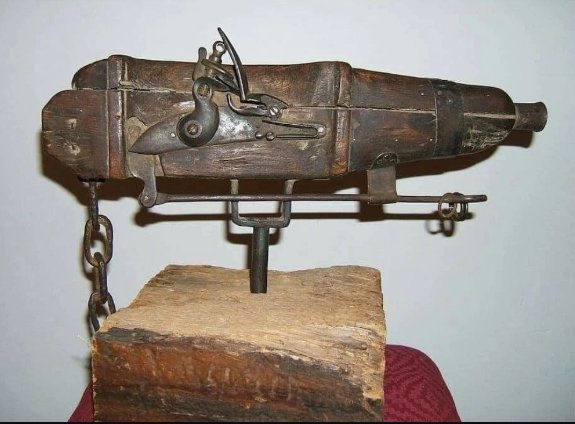A little late for Hallowe’en but interesting nonetheless
You may have heard that during the 18th and 19th centuries, the cemeteries of North America and Europe were full of "resurrection people."
That sounds nice, but these people were not nice.
They were grave robbers, paid by doctors or medical students to dig up freshly buried bodies.
Because they needed corpses to dissect them in anatomy class.
Bodies were not donated for medicine at that time and therefore the shortage had to be bridged somehow.
There was a shadow trade in corpses.
Families of the dead used various bizarre technologies to protect themselves from the theft of the bodies of their loved ones.
They built wrought-iron cages over the graves, but they also set up "cemetery cannons".

It was a flintlock weapon mounted on a rotating base and stand. So it could swing freely.
The device was at the foot of the tomb and was intended to aim at the head of an unprayed-for visitor.
It was ignited by a series of three or more trip wires arranged in an arc.
Thieves who did not know this and came in the night would trip and set off the fatal shot.
Some of the grave robbers sent women dressed in black like widows with children with them to watch the graves during the day and report the locations of graveyard guns to their accomplices.
Unfortunately, the resurrectionists stole the bodies mostly in poor people's graves.
This means that families who could afford cemetery cannons and other protection needed them the least.


You may have heard that during the 18th and 19th centuries, the cemeteries of North America and Europe were full of "resurrection people."
That sounds nice, but these people were not nice.
They were grave robbers, paid by doctors or medical students to dig up freshly buried bodies.
Because they needed corpses to dissect them in anatomy class.
Bodies were not donated for medicine at that time and therefore the shortage had to be bridged somehow.
There was a shadow trade in corpses.
Families of the dead used various bizarre technologies to protect themselves from the theft of the bodies of their loved ones.
They built wrought-iron cages over the graves, but they also set up "cemetery cannons".
It was a flintlock weapon mounted on a rotating base and stand. So it could swing freely.
The device was at the foot of the tomb and was intended to aim at the head of an unprayed-for visitor.
It was ignited by a series of three or more trip wires arranged in an arc.
Thieves who did not know this and came in the night would trip and set off the fatal shot.
Some of the grave robbers sent women dressed in black like widows with children with them to watch the graves during the day and report the locations of graveyard guns to their accomplices.
Unfortunately, the resurrectionists stole the bodies mostly in poor people's graves.
This means that families who could afford cemetery cannons and other protection needed them the least.









